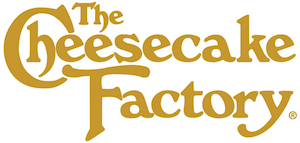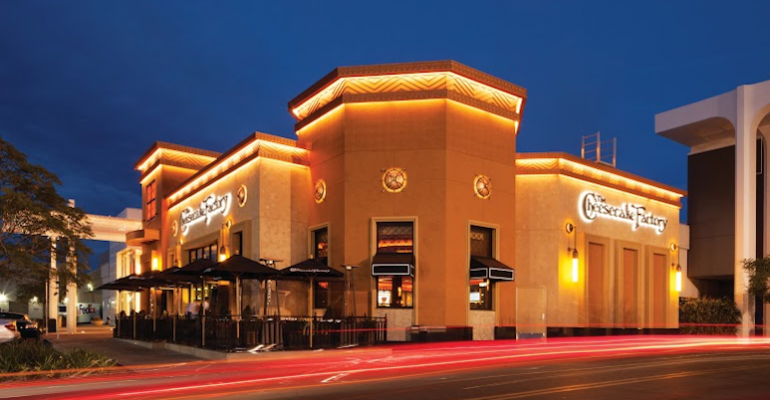At a time when consumer tastes are changing, fans of The Cheesecake Factory know they can always find what they want on the menu: Something for everyone.
The 187-unit chain was the top pick within Casual Dining in this year’s Consumer Picks survey, earning the highest marks for Food Quality, Cleanliness, Reputation, Likely to Recommend and, unsurprisingly, for Menu Variety.
Perhaps more than anything else, it is The Cheesecake Factory’s broad menu of more than 250 items made from scratch — from Avocado Eggrolls to Pasta Carbonara — that sets the brand apart.
The trick has been keeping the vast menu relevant. Over the past year, The Cheesecake Factory has struck a chord in that regard with the addition of a new “Super” Foods menu, with dishes like almond-crusted salmon served over kale; shaved Brussels sprouts and quinoa; and the Super Antioxidant Salad with spinach, kale, broccoli, avocado, roasted pear and blueberries with a lemon-blueberry vinaigrette.
David Gordon, president of The Cheesecake Factory Inc., said the new lineup was such a hit after it was introduced last summer that it was expanded with a new menu rollout earlier this year.
“We knew ‘Super’ Foods would resonate, especially with Millennials,” Gordon said. “‘Super Foods’ is probably one of our greatest areas of competitive advantage.”

The Calabasas Hills, Calif.-based chain also struck gold with the addition three years ago of its SkinnyLicious menu, a platform of dishes under 590 calories, as well as more small plates and snacks. The move added options for health-minded customers, even though more often than not those customers finish their lower-calorie meal with a slice of indulgent cheesecake.
Gordon said internal surveys indicate that about one quarter of customers say they come specifically for the legendary cheesecakes, which are available in about 70 varieties throughout the year, from White Chocolate Raspberry Truffle to Caramel Pecan Turtle.
Food may be a focal point, but the experience is also a top priority, said David Overton, The Cheesecake Factory founder and CEO, during an earnings call with analysts in February.
The company is increasingly turning to technology to enhance the customer experience.
In the second quarter, The Cheesecake Factory will roll out a new mobile app dubbed Cake Pay that will allow customers to pay their bill with a smartphone, eliminating the pain point of waiting for servers to bring the check.
After testing the app in three units, Overton said, “We feel like it certainly can enhance somebody’s experience towards the end of their meal and give them that convenience to be able to pay whenever they’d like.”
Other casual-dining chains have moved further into consumer-facing technologies, like touchscreen tablets for ordering, but that’s not something that customers will see at Cheesecake Factory anytime soon, Gordon said.
Instead, technological advances are happening behind the scenes. For example, the chain recently rolled out a system of end-to-end encryption in restaurants to ensure that no customer credit card data is in the possession of the restaurant. In the event of a security breach, an increasingly common occurrence in the restaurant industry, hackers would come away empty handed.
Technology will also play a role in a new server training program set to roll out this year that will focus on “meeting today’s guests’ needs in service and hospitality,” Gordon said.
“We do think guests today are willing to wait for something that’s experiential,” he said. “It’s not just about the food.”
Branching out to grow sales
Given the challenges of executing the vast menu and keeping customer experience in mind, The Cheesecake Factory also takes pride in hiring and retaining top talent, Gordon said. In March, the chain was named among Fortune magazine’s 100 Best Companies to Work For, for the third consecutive year. It was the only restaurant company to make the list.
Meanwhile, The Cheesecake Factory is also exploring ways to meet customer needs outside its restaurants. About 10 percent of sales already come from takeout.
Within the next two months or so, the chain plans to begin testing the use of various third-party services to offer delivery.
Gordon said the test would be in California, but he declined to say where specifically.
The Cheesecake Factory attempted delivery years ago, but that was before the recent wave of tech-minded, third-party specialists began changing the landscape, allowing customers to use their smartphones to order their favorite restaurant meals to their homes with a few taps.
“We’re seeing Millennials wanting to eat at home more than ever before,” Gordon said. “But we want to make sure our brand is protected and that people feel its part of The Cheesecake Factory experience; that food is delivered the way we want.”
If delivery takes off, the move could open up a new line of incremental revenue for The Cheesecake Factory, which surpassed $2 billion in sales for the first time in 2015. The chain’s average unit volume for domestic restaurants grew to $10.6 million last year.
Still, like most concepts in casual dining, growing traffic remains a challenge.
 The Cheesecake Factory’s same-store sales rose 1.1 percent in the fourth quarter ended Dec. 29, but that included a 2.5-percent increase from pricing and 0.5-percent growth in positive mix. Traffic declined 1.9 percent, and company officials project traffic trends in fiscal 2016 to be flat to down 1 percent.
The Cheesecake Factory’s same-store sales rose 1.1 percent in the fourth quarter ended Dec. 29, but that included a 2.5-percent increase from pricing and 0.5-percent growth in positive mix. Traffic declined 1.9 percent, and company officials project traffic trends in fiscal 2016 to be flat to down 1 percent.
However, Overton said the brand is “navigating the challenging landscape by continuing with our successful recipe of menu and design innovation and operational excellence that is served to make The Cheesecake Factory one of the most differentiated restaurant concepts in the casual-dining industry.”
The brand is also growing in popularity overseas, and international expansion is accelerating. The chain has opened licensed units in the Middle East and Mexico.
This year, four to five international locations will open, including the first unit in China, within the Shanghai Disney Resort, a high-profile location that is likely to introduce the brand to a new global audience.
Domestically, the company expects to open eight restaurants, including one unit of sister brand Grand Lux Cafe. The goal is to reach 300 units in the U.S., which Overton said is well within the company’s reach.
In addition to the core brand and Grand Lux Cafe, the company operates one RockSugar Pan Asian Kitchen location.
And executives are actively looking for a new brand for expansion, either by acquisition or a concept grown internally, possibly taking a step away from casual dining.
“Fast casual is interesting to us, although fit and growth potential are our key priorities,” said Doug Benn, The Cheesecake Factory chief financial officer and executive vice president, during the February earnings call.
Correction: April 5, 2016 This story has been corrected to include the full name and title of David Overton, founder and CEO of The Cheesecake Factory. Due to an editing error, the original version of the story did not include this.
Contact Lisa Jennings at [email protected]
Follow her on Twitter: @livetodineout

